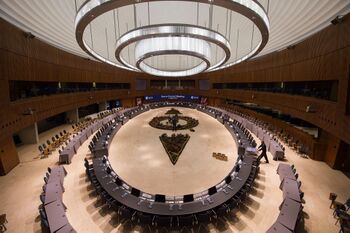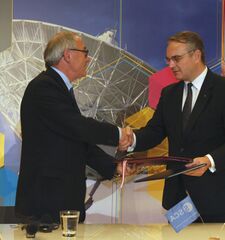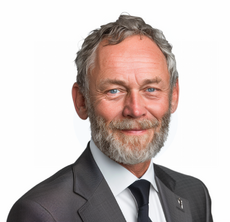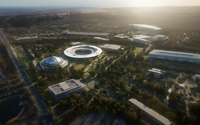User:Belfras/SandboxSpace1
Sodalitas Cosmos Agencia (latin) | |
 Logo | |
 Meatball | |
| File:JSA Membership.png Member states shown in dark blue Cooperative members in light blue suspended members in gray | |
| Abbreviation | SCA (latin) |
|---|---|
| Formation | 1 August 1968 |
| Type | Space agency Aeronautics research agency |
| Headquarters | Thessalona, Belfras |
Membership | Member states: |
Official languages | latin (official) |
Director-General | Deckard Gleise |
Deputy Director-General | Konstantinos Papaioannou |
The Joint Space Agency (JSA) is an international organization dedicated to space exploration, scientific research, and technological innovation. Established in 1968 by Belfrasian Federation, the Latin Empire, and the Republic of Sante Reze, the JSA was founded to combine the resources and expertise of its member nations in pursuit of advancing humanity’s reach into space. Having been created following significant space infrastructure development by the tri-national space alliance, the agency utilised these advancements to achieve its first major milestone in 1973 with a series of successful moon landings, firmly establishing itself as a leader in the exploration of space.
Over the decades, the JSA expanded its membership to include nations from around the world, evolving into the largest and most inclusive space agency in existence. Its mission is to foster international cooperation, promote the peaceful use of outer space, and drive innovation to address both scientific and practical challenges.
The agency operates under the guidance of a Space Council, which is composed of representatives from each member nation. This governing body oversees the agency’s strategic priorities and ensures equitable collaboration among members. The JSA maintains facilities across its member nations, including research centers, training programs, and engineering hubs. Its primary launch facility, however, is located in Sante Reze, serving as the heart of its space exploration operations.
The JSA is at the forefront of humanity’s presence beyond Earth, operating a functional partially-manned moon base that supports scientific research and serves as a staging ground for future missions. With plans to conduct crewed missions to Mars by 2035, the agency continues to lead efforts to expand humanity’s understanding and utilization of outer space.
It's primary spaceport is the Eporte KeParaguasure Okeere (EKPO) (International Port of Paraguasurun) located in Sante Reze. JSA also conducts space launches at the Cape Castille Space Centre located in Gristol-Serkonos for satellites going into polar orbit. It previously operated from Galileo Space Center in Belfras until it was closed in 1972.
History
In the late 1950s, Belfras, Latium, and Sante Reze united their space exploration efforts, forming the foundation of the Tri-nation Space Coalition (TNC). Each nation brought its expertise and institutions to the partnership: Belfras through the Space Technology Aeronautical Research Agency (STAR), Latium through Cursus Astrum (CA), and Sante Reze through the Kimiyye Hendreri Ofurufu Populeris (KHOP). Operating from the Galileo Space Center, the TNC achieved a series of groundbreaking milestones that propelled humanity into space and solidified their cooperative venture.
The Archytas Tutso Program marked the TNC’s first step into space exploration. These missions were designed to test the feasibility of human spaceflight and validate essential systems. In 1961, XXXX of XXXX became the first astronaut launched from the Galileo Space Center, riding the Aurora 1 capsule on a 15-minute suborbital flight. The program continued with enhanced suborbital missions, refining spacecraft systems and laying the groundwork for orbital missions.
Building on these early successes, the TNC launched the Centaur Program, focusing on advanced space operations, including orbital flights, docking, and extravehicular activity (EVA). In 1964, Centaur 1 completed the TNC’s first crewed orbital mission, with XXXX of Latium and XXXX of Belfras aboard. This mission demonstrated the capability for sustained operations in space. Milestones of the Centaur Program included the first docking in 1965, the historic EVA by XXXX of Sante Reze in 1966, and the 14-day orbital mission of Centaur 7 in 1967, which proved the durability of life-support systems for long-term missions.
Throughout these programs, the collaboration between STAR, CA, and KHOP showcased the power of international unity. Engineers, scientists, and astronauts worked together at the Galileo Space Center, sharing expertise and fostering a spirit of mutual respect and camaraderie. These achievements paved the way for more ambitious missions. By 1968, the success of the Archytas Tutso and Centaur programs led to the formation of the Joint Space Agency (JSA), consolidating the resources and expertise of all three nations under one organization. This marked the beginning of a new era, with the JSA focusing on lunar exploration and more complex space missions.
The accomplishments of the early Tri-nation Space Coalition remain a testament to international collaboration and ingenuity. From the experimental flights of Archytas Tutso to the orbital breakthroughs of Centaur, the program laid the foundation for the bold exploration of space and demonstrated what humanity could achieve when united by a common goal.
Foundation and early history
To be added
First moon landings
The Selene Project was the Joint Space Agency’s landmark program to achieve humanity’s first crewed lunar landings and conduct extensive exploration of the Moon. Operated from 1968 to 1979, the project symbolized international collaboration the member nations that joined the agency. Named after the Greek goddess of the Moon, Selene was a technical and diplomatic achievement, marking a new era in space exploration.
Following the success of the Centaur Program, which perfected orbital rendezvous, docking, and extravehicular activities (EVAs), the JSA set its sights on a far more ambitious goal: landing humans on the Moon. The Selene Project was tasked with not only achieving this historic feat but also advancing scientific understanding of the Moon and developing technologies that would pave the way for further exploration. The first mission of the Selene series was an uncrewed test of the Hermes Command Module (HCM) and its launch system, the Tandem-V rocket. This mission, flown in 1970, validated the spacecraft’s performance and ensured it could handle the stresses of deep-space travel and reentry. The second Selene flight in 1971 conducted a low lunar orbit test and the 1972 flight of Selene III scouted for potential landing sites and practiced the last elements of technology before the main mission in 1973.
Selene IV launched July 16 1973 from Eporte KeParaguasure Okeere (EKPO) in Sante Reze carrying astronauts Cassius Orion, Ahkin Kanek and XXXX. Commander Cassius Orion and LM Pilot XXXX became the first humans to set foot on the lunar surface. Their lunar module, Eos, landed in the Lacus Solis region. Cassius Orion’s historic first words, “In unity, we stride across the heavens, shaping the path for all humankind,” symbolized the program’s ideals of cooperation and progress. The fifth and sixth Selene missions expanded explorations to different regions of the moon, utilizing rovers and longer-duration stays. Selene IV also tested modular habitat components for a potential lunar base.
Selene VII, which launched in 1977, became the first time a crewed vehicle launched from EKPO suffered an in-flight abort after the first stage booster failed just over a minute into the flight. The three astronauts utilised the escape system successfully and escaped with only minor injuries incurred by the escape system itself. Selene VII was a failure in that it represented a significant setback in the program as it was meant to test advanced surface operations and procedures for future lunar bases, which will later be stated as a point which delayed the foundation of the first lunar base. It was also seen as a failure as the loss of the hardware and investigations afterwards caused significant delays which impacted the program schedule irreversably for the remainder of it's existence. However the successful use of the Launch Escape System underscored the robustness of the agency's commitment to crew safety and the incident provided an opportunity for furthur refinement of safety systems and procedures.
The Selene Project returned over 400 kilograms of lunar material and provided critical insights into the Moon’s geology and origins. Its achievements laid the foundation for later programs, including plans for lunar bases, securing the JSA’s position as a leader in space exploration.
Member states and budget
| Member state | JSA convention | Representative | National programme | Contributions | ||
|---|---|---|---|---|---|---|
| Test1 | Test2 | Test3 | ||||
| Full member states | ||||||
| TBD | TBD | TBD | 1 | 2 | 3 | |
| 1 August 1968 | Odoacer Bursio | STAR | 1 | 2 | 3 | |
| TBD | TBD | TBD | 1 | 2 | 3 | |
| TBD | TBD | TBD | 1 | 2 | 3 | |
| 20 October 1971 | TBD | SARA | 1 | 2 | 3 | |
| 1 August 1968 | TBD | CA | 1 | 2 | 3 | |
| TBD | TBD | TBD | 1 | 2 | 3 | |
| TBD | TBD | TBD | 1 | 2 | 3 | |
| TBD | TBD | TBD | 1 | 2 | 3 | |
| TBD | TBD | TBD | 1 | 2 | 3 | |
| TBD | TBD | TBD | 1 | 2 | 3 | |
| 6 October 1978 | TBD | NARA | 1 | 2 | 3 | |
| 1 August 1968 | TBD | KHOP | 1 | 2 | 3 | |
| TBD | TBD | TBD | 1 | 2 | 3 | |
| 8 April 1972 | TBD | DARD | 1 | 2 | 3 | |
| TBD | TBD | TBD | 1 | 2 | 3 | |
Applicant States
Suspended States
Enyama
Following the outbreak of the Enyaman Civil War on 19 September 2019 the Joint Space Agency formally announced that as no clear government existed that the membership to the Agency would be immediately suspended until otherwise stated. Since this decision, which was made in December that same year, no other information has come to light regarding the suspension of membership. It is known, however, that many employees of the JSA that are Enyaman in nationality have since relocated permanently to either Belfras or Sante Reze.
Application process
As outlined in the conventions, national membership to the Joint Space Agency is outlined with the following; "The accession of national bodies to the agency must be evaluated upon the base principles of it's contributions, it's goals, it's capabilities and weighed against any threats it may pose to the agency itself.". The interpretation of this throughout the JSA's history has been that nations wishing to participate within the agency must prove that they will provide a good contribution in equity with other member nations without posing any threats to the stability of the agency.
The first step in the process, again as outlined within the conventions, is that the applicant nation signs an observer agreement. This agreement is considered to be the 'negotiating' phase, as the nation and the JSA will now enter discussions for an cooperation agreement to be signed, while permitting both sides to have access to eachothers space agencies to a limited degree to ensure proceeding forward is mutually beneficial.
A JSA Cooperation Agreement provides a nation limited financial responsibilities within the JSA but with limited options within the organisation such as no voting power and a severe reduction in possible projects or programmes they may participate in. This is publicly viewed as a probationary phase. In some cases this has lasted a matter of weeks, in others it has lasted for upwards of ten years. The length, it has been noted, lies within gaining enough votes for accession and any conversions needed to bring the applicant nation's space agency to a standard where it will provide a whole net positive to the Joint Space Agency. It is at this point that the applicant state is invited to sign a full membership agreement.
Budget
Collaboration
International Aeronautical Union
The partnership between the Joint Space Agency (JSA) and the International Aeronautical Union (IAU) represents a significant collaboration in the field of space exploration, initiated in XXXX. This alliance has evolved over the decades to achieve numerous milestones in lunar exploration and now aims to tackle exciting new challenges ahead, including the development of a new international space station. The collaboration between the JSA and IAU began in XXXX, driven by a shared vision to advance human knowledge and technological capabilities in space. Recognizing the potential benefits of joint efforts, both agencies forged a strategicalliance that allowed them to combine their expertise, resources, and ambitions.
One of the hallmark achievements of this partnership has been the successful participation of the IAU in several moon landings conducted by the JSA as part of it's Pioneer program. Through this cooperation, IAU has contributed its vast scientific knowledge and expertise in aerospace engineering, which has enhanced mission planning, technology development, and astronaut training. These joint expeditions to the Moon have allowed both organizations to conduct scientific research, gather precious data, and perform experiments that have deepened our understanding of lunar geology and potential resources.
The ongoing partnership between the Joint Space Agency and the International Aeronautical Union stands as a testament to the power of collaboration in advancing the understanding of space. Through the shared history of successful lunar missions and a joint commitment to the creation of new infrastructure and future cooperation, both agencies exemplify how cooperation can lead to groundbreaking discoveries and forge pathways for future advancements in space exploration. This partnership not only enhances scientific research but also empowers nations to work together towards common goals, inspiring future generations to reach for the stars.
Management
As planned in the Conventions two organs are defined which work together to run the Joint Space Agency; the Space Council and the Director-General. The Space Council is composed of Representatives of the member states which meets as required at Representative or delegate level. The Director-General is appointed by the space council and serves at their leisure and in their duty represents the JSA in it's acts and executes policy defined by the Space Council. The Council has set-up subordinate bodies to be assisted in it's duties. Each of the Committees and Boards take decisions, make recommendations or are kept informed according to the amount of powers invested in them by the Council in their given area of responsibilities. Each Member States nominates its representation to the boards and committees; these delegates are often accompanied by experts.
Space Council
The primary role of the Space Council is to establish the direction and policy of the Joint Space Agency. Representatives of the space council meet every two to three years to assess current challenges, opportunities, and technological advancements in space exploration and then decide on the agency's priorities and initiatives for the forthcoming period. The Space Council is also responsible for overseeing the implementation of these policies, and to this end they appoint a director-general who will act as the executive officer for the agency and ensure that the agency's activities align with the established goals and regulatory guidelines. Oversight over these activities are conducted through an executive committee whose responsibilities include conducting oversight over all established activities and programmes, over the different divisions and support services, and finally over the director-general and administrative staff themselves.
Representatives in the Space Council will be charged with appointing teams of experts to their staff and assigning delegates to attend lesser meetings which are focused on specific programmes and initiatives. These delegates and meetings allow for focused discussions, expert contributions, and a more agile decision-making regarding particular projects by avoiding unnecessary administrative efforts. As stated in the conventions, the contributions of the Representatives as representatives of the members states promotes international cooperation. This collaboration fosters a unified approach to address global challenges in space research, technological advancement, and policy regulation, furthering the peaceful exploration and utilization of outer space.
Director-General
The Director-General (DG) of the Joint Space Agency is the Chief Executive Officer over it's actions and is responsible for the definition, implementation, and development of the agency's space infrastructure and activities. The office is also responsible for ensuring all actions taken by the JSA align with policy and regulatory guidelines set by the Space Council. As the Chief Executive Officer, the Director-General is charged with overseeing the programmes and directives which control and maintain the agency's launchers, satellites, space stations and current lunar exploration.
The key responsibilities for the office include developing and implementing the JSA's long-term vision and strategies to advance the infrastructure and exploration of space. They ensure that the agency's activities align with policy and regulations set out by the Space Council and to this goal oversees the day-to-day operation of the JSA, managing a diverse workforce of scientists, engineers, and administrative staff. They are responsible for ensuring that the budget is allocated appropriately, ensuring that future financial planning is carried out effectively and on time.
While the Space Council sets out policy and regulations, the DG has the responsibility of forming space policy under those guidelines and cooperating with the Space Council to ensure that, if necessary, the policy and regulations are altered to meet new conditions as necessary. They hold meetings with national governments within and outside of the JSA to promote international cooperation and ensure that the dialogue on the exploration of space is continued to be carried out. They are also the spokesperson for the JSA, promoting the projects and achievements of the agency to the public and media. In line with the new convention of the young persons outreach signed 1996, the DG is also responsible for ensuring that future generations are inspired and that education facilities exist to educate the next generation of scientists, astronauts, and pioneers.
Finally, the Director-General utilises an administrative structure of Operations Directors, Facilities Directors, and Project/Programme Directors to run the divisions and other bodies within the agency. In the event of an emergency, the DG has the ability to override the Space Council's guidelines and policies if it is reasonable to do so in order to mitigate impacts on ongoing projects and missions.
Since 2018 the Director-General has been Dr. Deckard Gleise of the Belfrasian Federation. Prior to his appointment by the Space Council, he had been the Operations Director of Technology, Engineering and Quality (otherwise known as the Director of Technology) and had previously been responsible for the implementation of new technologies at EKPO Space Port. The Deputy Director-General, Konstantinos Papaioannou, is a Gristo-Serkonan of Belfrasian descent. Formerly headed SARA's Department of Satellite Operations before his appointment to JSA's Deputy Director-General position by the Space Council in 2020.
Offices and Facilities
The offices and facilities operated by the Joint Space Agency are distributed among various countries and areas. The primary locations, such as the primary headquarters, launch facility and research campus are separated among the three founding members in an arrangement that dates back to the initial founding of the agency.
- The JSA administrative headquarters in Thessalona, Belfras. This location houses the leadership of the Joint Space Agency, the meeting location for the Space Council, and also houses it's astronaut corps, security forces, and public relations office.
- The Messala Spatium Recircare et Disciplina Facilitas (MSRF) near Florentia, Latium, this is the largest facility dedicated to furthering research and technological developments by the agency.
- Ekporte KeParaguasure Okeere (EKPO) Space Center in Sante Reze. This is the agency's primary launch facility.
- Facilities owned and operated by member-state space agencies but have close collaboration with the JSA include;
- Cape Castille Space Port in Gristol-Serkonos, this is owned and operated by SARA, but has been responsible for JSA polar launches since the 1980s.
- National Space Training center in Belfras. This has trained new astronauts since the 1960s and is responsible for training the initial astronauts that the JSA utilised.
| Field Center | Primary Location | Facility Director | |||||
|---|---|---|---|---|---|---|---|
| JSA Headquarters | Belfras | Lydon Orinis | |||||
| EKPO Space Port | Sante Reze | TBD | |||||
| MSRF Center | Latium | TBD | |||||
| Collaborative facilities | |||||||
| Cape Castille Space Port | Gristol-Serkonos | Dr. Adélaïde Villeneuve | |||||
| National Space Training Center | Belfras | Daud Winso | |||||
JSA's headquarters campus in Belfras
EKPO, the JSA's main launch site in Sante Reze
SRTC research center in Latium
Cape Castille Space Centre, JSA's polar launch site in Gristol-Serkonos
Editor-only
Category:Space agencies category:Joint Space Agency category:Ajax











